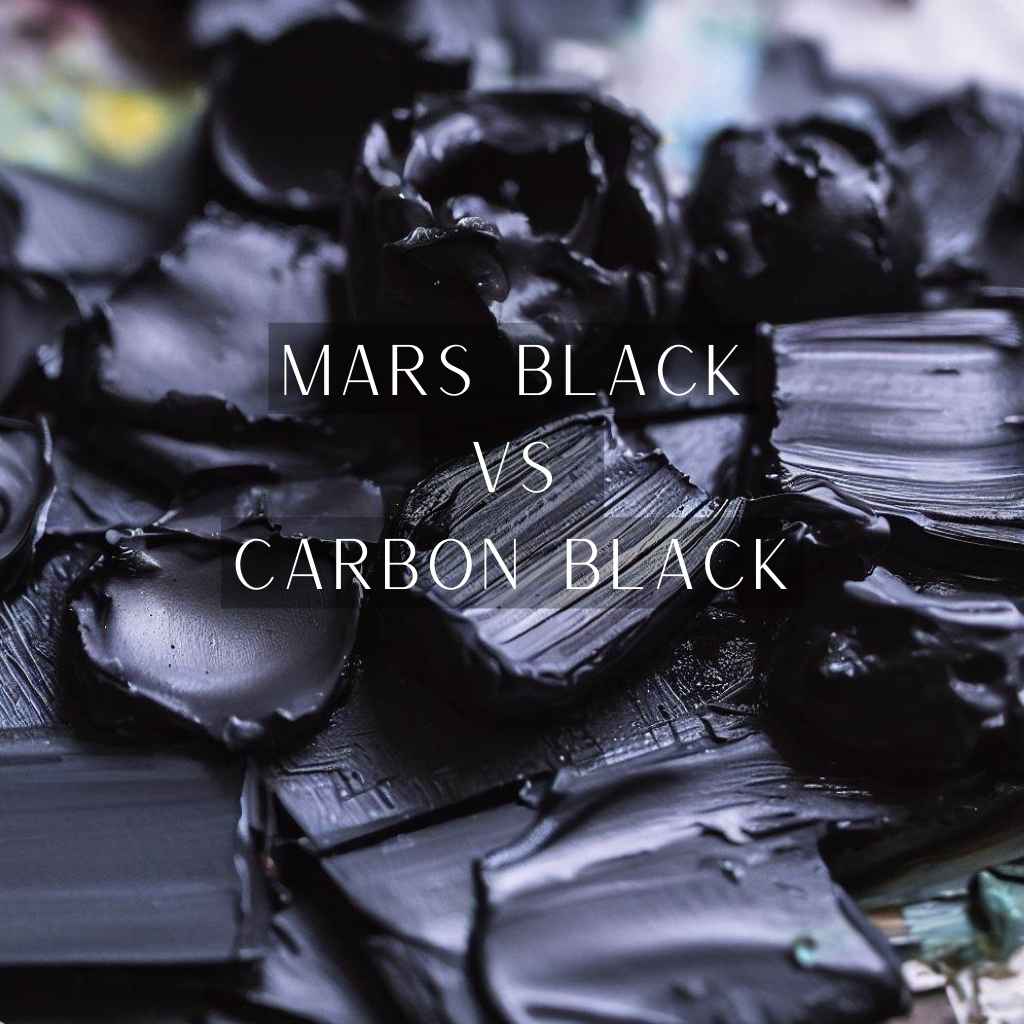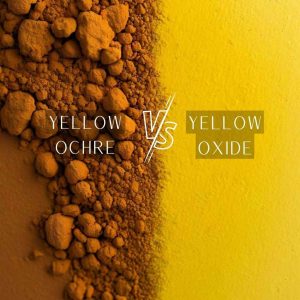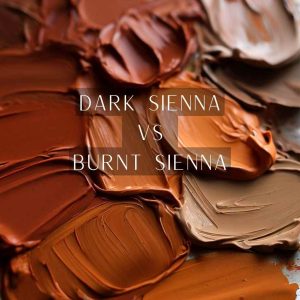Darkness on a canvas is not merely the absence of light; it’s a realm where emotions and stories unfold. As artists, we’re no strangers to the power of Mars black and carbon black, these deep pigments that hold within them the essence of shadows and mysteries.
But here’s the intriguing question that often whispers through art studios and galleries: which of these enigmatic pigments truly reign supreme?
The world of art stands witness to an ongoing clash of titans: mars black vs carbon black. In this exploration, we’ll delve into the very fabric of these pigments, their unique attributes, and their influence on the art world.
Get ready to unlock the secrets behind the allure of these captivating blacks, as we traverse the intricate pathways of shades, contrasts, and artistic expression.
Mars Black: The Rustic Shade
Mars Black, with its enigmatic name, originates from an intriguing source. This pigment is derived from iron oxide, a compound that carries a rich history in both geological formations and artistic creations.
The process involves the transformation of iron ores through controlled heating, resulting in the fine particles that constitute Mars Black pigment.
The deep, velvety black of Mars Black pigment is a result of its iron oxide composition. This composition gives it its unique properties, impacting not only its color but also its interactions with other pigments and mediums. The iron oxide makeup influences its density, texture, and ultimately its opacity when applied.
Carbon Black: The Elemental Depth
Carbon Black, a pigment with roots in chemistry, is produced through the incomplete combustion of hydrocarbons. This process yields microscopic particles that reflect minimal light, resulting in the characteristic deep black hue.
The intricate dance of carbon atoms within these particles is what gives Carbon Black its intense darkness.
The crystal structure of Carbon Black particles plays a vital role in their light-absorbing properties. The arrangement of these particles captures light within their crevices, creating an effect of deep absorption. This unique structure contributes to the pigment’s velvety matte finish.
Mars Black vs Carbon Black: Comparative Analysis
These two enigmatic pigments each have their own unique qualities and characteristics that make them intriguing choices for artists-
Color Intensity and Undertones
Mars Black radiates a warmth that is distinct from the coolness exuded by Carbon Black. This divergence in undertones influences the emotional resonance each pigment evokes. Mars Black’s warmth creates a sense of comfort and familiarity, reminiscent of cozy shadows and earthy depths.
In contrast, Carbon Black’s coolness imparts an air of mystery and sophistication, inviting the viewer to explore the enigma within its depths.
Mixing and Versatility
Mars Black, with its warmth, often blends harmoniously with other pigments, lending depth and dimension to the palette.
On the other hand, Carbon Black’s intense tinting strength demands a more cautious approach. When integrated into a mix, Carbon Black can dominate and alter the entire color scheme, requiring artists to exercise precision in its usage.
While Mars Black is known for its versatility and cooperative nature, Carbon Black invites experimentation with a touch of careful restraint.
Lightfastness and Permanence
Both Mars Black and Carbon Black offer commendable lightfastness, ensuring the longevity and vibrancy of artworks over time. This quality is essential for artworks intended to withstand exposure to light, ensuring that the depth and richness of the pigments remain intact.
The ability of both pigments to withstand the test of time underscores their significance as reliable choices for artists aiming to create enduring pieces.
Texture and Handling
Mars Black, with its slightly gritty texture, brings a certain organic quality to its application. This texture can be advantageous in certain artistic styles, as it allows artists to create textured surfaces that interact dynamically with light and shadow.
On the contrary, Carbon Black’s fine particles result in a smoother application, contributing to its matte finish. The velvety texture of Carbon Black’s matte quality adds an air of sophistication and elegance to artworks, making it a popular choice for creating depth without sacrificing refinement.
Suitability for Different Mediums
The choice between Mars Black and Carbon Black is also influenced by the medium an artist works with. While both pigments find their place in a variety of mediums, each has its own strengths that cater to specific artistic intents.
Mars Black shines particularly in acrylics and oils, where its warmth can be harnessed to create immersive and emotionally resonant compositions.
On the other hand, Carbon Black’s matte finish lends itself exceptionally well to mediums like ink and gouache, where its ability to create striking contrasts and depths takes center stage.
Mars Black and Carbon Black: Application in Art
Among the myriad of colors, Mars Black and Carbon Black stand out as profound choices, each contributing its unique qualities to artistic compositions.
Here is how these dark pigments find their application in the realm of art-
- Mars Black in Traditional Uses: Mars Black has etched its presence in art history with a wide range of applications. In traditional techniques, it excels as an underpainting pigment, creating a solid foundation for other colors to build upon.
Its deep, warm undertones make it an essential tool for shading and creating dramatic contrasts, especially in portraits and still-life compositions.
- Mars Black in Contemporary Art: Mars Black’s versatility extends to contemporary art forms, where artists harness its unique characteristics to create visually striking compositions.
Its warm undertones evoke feelings of familiarity and depth, while its opacity allows for effective coverage, making it ideal for both subtle nuances and bold statements.
- Carbon Black in Modern Art: The emergence of Carbon Black as a dynamic artistic tool has breathed new life into contemporary art forms. Its matte finish adds a layer of sophistication and depth to artwork, offering a unique textural experience.
Carbon Black’s intense tinting strength makes it a valuable asset for artists seeking to experiment with shades and tones.
In modern art, it finds a place among artists who embrace its deep coolness to convey emotions, mysteries, and bold statements. Its utilization of ink-based artworks highlights its ability to create contrasts and evoke intricate emotions.
- Balancing Tradition and Innovation: When considering Mars Black and Carbon Black in the realm of art, it’s a dance between tradition and innovation.
Mars Black, rooted in centuries of artistic practice, continues to hold its own, providing a reliable foundation for classic techniques. Its warmth infuses artworks with a timeless charm, resonating with the past while remaining relevant in contemporary contexts.
Carbon Black, on the other hand, steps into the spotlight as a symbol of modernity and experimentation. Its matte finish and intense tinting strength allow artists to challenge conventions and create art that defies traditional boundaries.
- Capturing Depth and Emotion: Both Mars Black and Carbon Black play a crucial role in capturing depth and emotion within artistic compositions. Mars Black’s warmth can evoke feelings of nostalgia, intimacy, and comfort, making it an excellent choice for conveying human emotions and natural elements.
Carbon Black, with its coolness and matte quality, introduces an air of mystery and enigma, enabling artists to explore the complex nuances of the human experience. The combination of these pigments with other colors further amplifies their ability to evoke emotions and create multi-layered narratives.
- Pushing Boundaries and Experimentation: In the hands of modern artists, both Mars Black and Carbon Black become tools for pushing artistic boundaries and experimentation.
Mars Black’s traditional use of underpainting and shading can be reimagined to create contemporary compositions that balance tradition with innovation.
Carbon Black, with its matte finish and strong tinting strength, encourages artists to explore contrasts, textures, and the interplay of light and shadow in innovative ways.
This willingness to experiment with these pigments opens doors to fresh artistic expressions that challenge perceptions and spark new conversations.
FAQs
- Can I use Mars Black and Carbon Black together to create a balanced composition?
Absolutely! Combining Mars Black and Carbon Black in a single artwork can create a balanced composition with contrasting elements. The warm-cool duality of these pigments can lead to a visually captivating and emotionally resonant artwork.
- Can I layer Mars Black and Carbon Black to achieve different effects?
Layering Mars Black and Carbon Black can yield captivating effects, especially when aiming to create nuanced shadows or intricate textures. Experiment with layering techniques to uncover the depth and complexity that these pigments can bring to your artwork.
- Do Mars Black and Carbon Black have any cultural significance in art?
Over time, Mars Black and Carbon Black have become symbols of depth, contrast, and emotional resonance in art. Their utilization has been shaped by cultural contexts and individual artist preferences, contributing to the evolving narrative of artistic expression.
- Can Mars Black and Carbon Black be used for architectural renderings?
Yes, both pigments can be incorporated into architectural renderings to create depth and realism. Mars Black can help achieve the depth of shadows, while Carbon Black’s matte finish can emphasize the intricacies of architectural details.
Wrapping Up
As we stand at the culmination of this artistic journey, the shades of Mars black vs carbon black reveal their multifaceted personas.
Navigating the intricacies of artistic expression, we’ve witnessed the warm embrace of Mars Black and the enigmatic allure of Carbon Black. The battle of Mars Black vs Carbon Black isn’t just a choice between colors; it’s a voyage into the realms of passion and creativity.
You’ve been armed with the knowledge of their attributes, characteristics, and applications. Now, it’s time to take that knowledge and let it flow onto your canvas, breathing life into your visions.




